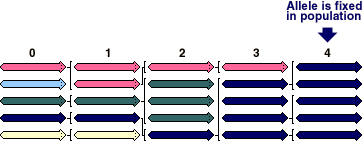Genetic Drift Simulation
What is Genetic Drift?
|
To begin with, let's examine a simple model of a population of fictional organisms called driftworms. In the following examples, the driftworms have only one gene, which controls skin color. Worms reproduce asexually and are connected to their parents by lines. In the population of five worms below, each worm gives rise to exactly one worm in the next generation. There are five alleles (skin colors) at generation 0 and the same five alleles at generation 4.
Note that the model above starts with a diverse population (5 worms, 5 alleles). What would the model look like if there were no diversity to begin with?
With no diversity in generation 0 and no forces of evolution acting on the population, the model above begins and ends with all worms in the population having the same allele. |
The forces of evolution
|
In the above examples, the populations of worms are not evolving--neither the genotypes nor phenotypes are changing. For evolution to occur, there must be mutation, selection, or random genetic drift. These are the three major forces of evolution. The cause changes in genotypes and phenotypes over time. They also determine the amount and kind of variation seen in a population at a given time. This simulation focuses on drift (mutation and selection are covered in later simulations). |
Random genetic drift
|
When genetic drift is introduced into the model, the results are different:
The role of chance In real life, some individuals have more offspring than others--purely by chance. The survival and reproductions of organisms is subject to unpredictable accidents. It doesn't matter how good your driftworm genes are if you get squished by a shoe before producing offspring.
None of the above events has anything to do with the dead organism's genotype or phenotype--these events occurred purely by chance. Fixation of an allele In a population model with genetic drift, alleles will eventually become "fixed". When an allele is fixed, all members of the population have that allele. In the graphic below, note that the dark blue allele fixed after 4 generations.
|
<< DNA to phenotype | About the simulation >>
The University of Arizona
February 24, 1999
Contact the Development Team
http://www.biology.arizona.edu
All contents copyright © 1998. All rights reserved.



